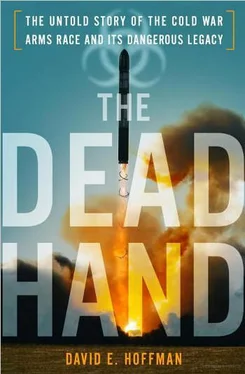“We hid it,” Yarynich said. “We should have announced from the very beginning, here it is, we are having trials. But we hid it. If you don’t know about it, it’s bad. It means you might take a decisive step, and then what?” This prospect worried Yarynich for many years.
On November 13, 1984, the Soviet military carried out a major test of Perimeter. The Leningrad design bureau simulated the General Staff command post. A signal was sent to a low-frequency transmitter in Moscow. Then the signal was transmitted to the command rocket at the Kapustin Yar test range on the banks of the Volga River in southern Russia. The command rocket took off and flew toward Lake Balkhash in Kazakhstan. Along the entire flight, the command rocket delivered the launch order, as a test, and receivers were listening across the country. During the test, Yarynich watched reports come in; some signals were stronger, others weaker.
Among other locations, the command rocket signal was received by an intercontinental ballistic missile located at the Tyuratam test range, also in Kazakhstan. The missile was poised to launch. In conditions of nuclear war, it would have lifted from the silo immediately, but the Soviet officials delayed it during the test because they suspected American satellites were monitoring every move. A while later, the big missile launched and flew to the Kamchatka Peninsula, hitting a target there. 16
The test was a success, and the system was put on combat duty in the new year, 1985.
————— 7 —————
MORNING AGAIN IN AMERICA
Ronald Reagan opened 1984 with bold declarations of an American renaissance. “America is back” with “renewed energy and optimism,” he said in the State of the Union address on January 25. He urged the American people to “send away the hand-wringers and doubting Thomases,” and added, “The cynics were wrong—America never was a sick society.” Polls showed Reagan enjoyed high public approval ratings. The mood of the country was upbeat despite the collapsed nuclear arms talks with the Soviets, a misadventure in Lebanon and record budget deficits. Reagan’s optimism had been a tonic for the debilitating years of Vietnam, Watergate, the Iran hostages and the energy crises of the 1970s. A deep recession had wrung hyperinflation out of the economy, and growth was rebounding. An American high-technology revolution was taking hold. Reagan formally announced he was seeking reelection January 29. His campaign was framed by inspirational television commercials, including one titled “Morning Again in America,” which opened with glimpses of a farmhouse, followed by scenes of a wedding party and of an elderly man raising the American flag while young faces watched in adoration. As the flag filled the screen to the sounds of soft and stirring music, an announcer said, “It’s morning again in America … And under the leadership of President Reagan, our country is stronger, and prouder, and better. Why would we ever want to return to where we were less than four short years ago?”
After the tense months of the previous autumn, Reagan wrote repeatedly in his diary early in 1984 that he had come to realize Soviet leaders might have a genuine fear of the United States, and he yearned to talk them out of it. He acknowledged “my own attitudes toward the Soviets were changing a little.” 1The president of Yugoslavia, Mika Spiljak, visited Reagan at the White House February 1, and the president asked a lot of questions about the Soviet Union. “He believes that coupled with their expansionist philosophy they are also insecure & genuinely frightened of us,” Reagan wrote in his diary. “He also believes that if we opened them up a bit their leading citizens would get braver about proposing changes in their system. I’m going to pursue this.”
At Andropov’s funeral in Moscow, Chernenko had sent a conciliatory signal during a talk with Vice President Bush, saying, “We are not inherently enemies.” Reagan had yet to see a Soviet leader face-to-face and wondered if he should meet Chernenko. “I have a gut feeling I’d like to talk to him about our problems man to man & see if I could convince him there would be material benefit to the Soviets if they’d join in the family of nations, etc.,” he wrote February 22.
When Suzanne Massie, author of several books on Russian culture and history, came by to see Reagan on March 1, after a trip to Moscow, Reagan expressed admiration for her insights and said “she reinforced my gut feeling that it’s time for me to personally meet with Chernenko.” 2
The next day, Reagan held a high-level meeting to plan next steps with the Soviets. The secret gathering, kept off Reagan’s public schedule, brought together all of Reagan’s top cabinet and staff advisers on Soviet affairs. Reagan announced at the opening of the meeting he wanted to arrange a summit, to show Chernenko he was not the sort of person who would “eat his own offspring.” But the session wandered off, and ended without a decision. 3“I’m convinced the time has come for me to meet with Chernenko along about July,” Reagan wrote that night. 4On March 5, Reagan met West German Chancellor Helmut Kohl. Reagan recalled, “He confirmed my belief the Soviets are motivated, at least in part by insecurity & a suspicion that we & our allies mean them harm. They still preserve the tank traps & barbed wire that show how close the Germans got to Moscow before they were stopped. He thinks I should meet Chernenko.”
Reagan concluded that he needed a “more hands-on approach” to the Soviets. He sent a seven-page letter to Chernenko. “I tried to use the old actor’s technique of empathy: to imagine the world as seen through another’s eyes and try to help my audience see it through my eyes,” he said. “I said it was my understanding that some people in the Soviet Union felt a genuine fear of our country.” The letter ended with a handwritten postscript, recalling “Soviet losses in warfare through the ages.” He added, “Surely those losses, which are beyond description, must affect your thinking today. I want you to know that neither I nor the American people hold any offensive intentions toward the Soviet people.” 5
But Chernenko didn’t reciprocate, and rejected a summit. Reagan and Chernenko exchanged a half-dozen letters in the spring of 1984, to no effect. After a strategy session on the Soviets March 23, Reagan concluded: “I think they are going to be cold & stiff-necked for a while.”
In Moscow, the KGB director, Vladimir Kryuchkov, opened a conference at headquarters saying that RYAN—spotting preparations for nuclear attack—was still the overwhelming overseas intelligence priority. Kryuchkov declared that the risk of nuclear war had reached “dangerous proportions,” the Pentagon was driven by “the fantastic idea of world domination” and the White House was engaged in “the psychological preparation of the population for nuclear war.” Kryuchkov’s speech text landed on Gordievsky’s desk in London. It said the top priority was to get a copy of the secret war plans of the United States and NATO. 6Another urgent priority for Gordievsky and the London office was to monitor field exercises involving the cruise missiles stationed at the Royal Air Force base at Greenham Common. But according to Gordievsky, the London office had no intelligence sources for this; they sent British press reports to Moscow instead. 7
Early in 1984, Reagan had signed an order formally launching the research effort into his Strategic Defense Initiative. 8In the Kremlin, however, Soviet leaders were still worried about the threat from Pershing IIs and the ground-launched cruise missiles. The Pershing IIs were fast, but the cruise missiles more numerous. While 108 Pershing IIs would be deployed in West Germany, the plan was to station 464 cruise missiles in Belgium, Britain, Italy, Netherlands and West Germany. The cruise missile was a modified navy sea-launched Tomahawk, about twenty-one feet long, each carrying a single nuclear warhead. It would fly at 550 miles per hour to a target as far as 1,350 miles away. The ground-launched cruise missile was a wonder of technology. It could soar at high altitudes over hostile territory and then swoop down to fifty feet above ground level and be steered toward its target with a sophisticated, terrain-sensitive and radar-avoiding guidance system. The Soviets had nothing like it. 9
Читать дальше












